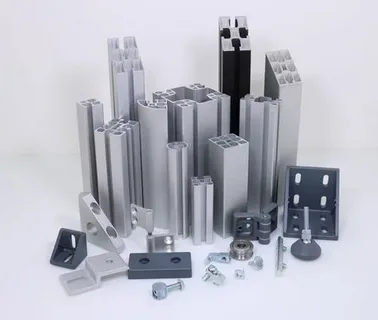The difference between cover profiles and insert seal profiles inMiniTec Aluminum Framing is not simply about appearance; it affects performance, durability, and the safety of assembled structures. Each profile type brings its own purpose, and understanding these differences helps designers choose the right part for their projects.
Geometry of Cover Profiles Offers Flush or Decorative Surfaces Whereas Insert Seal Profiles Allow Grooves for Flexible Sealing
Cover profiles are designed with geometry that sits flush against the surface of the extrusion, creating clean lines. This feature makes them useful in projects where the framework should blend seamlessly with the environment. MiniTec extruded aluminum framing benefits from this geometry because the cover pieces finish the open slots without changing the integrity of the structure. Decorative edges or flush surfaces can be achieved without adding weight or complexity.
Insert seal profiles, on the other hand, are shaped to allow flexible grooves. Instead of lying flat, these seals adapt to the contours of the channel, pressing tightly to form a barrier. That flexibility makes them important for enclosures or equipment housings built from MiniTec aluminum framing material. Their design prioritizes sealing against elements, making them suitable for machinery or workspaces that need dust and moisture protection.
Cover Profiles Used for Visual Finishing and Edge Protection While Insert Seal Profiles Serve to Seal Joints Against Dust or Moisture
Cover profiles provide a professional finish that hides the open channels of a modular aluminum framing system. Beyond appearance, they also act as edge protectors, covering sharp corners where workers’ hands may come into contact. By reducing exposure to raw edges, these profiles improve safety while maintaining a uniform aesthetic across the project.
Insert seal profiles are engineered with a different goal. Their function lies in sealing joints and filling gaps. They serve as barriers against dust, dirt, or liquid infiltration, which is essential for environments where cleanliness or climate control matters. While cover profiles focus on presentation, insert seals actively protect internal components, making them indispensable for technical equipment housed within MiniTec aluminum frame kit structures.
Installation Method of Cover Profiles Often Clip-on or Slide-on Contrasted with Insert Seal Profiles Requiring Insertion into T-slots or Channels
Installing cover profiles is straightforward. They are often manufactured with clip-on or slide-on features that allow them to snap into place along the extrusion. This quick application means assembly teams can finish large builds efficiently, giving MiniTec extruded aluminum framing both speed and simplicity during installation.
Insert seal profiles demand more precision in application. These profiles are pressed directly into T-slots or narrow channels, requiring the right amount of force for a secure fit. While this method may take longer, the result is a tight seal that performs under pressure. The difference in installation reflects their purpose: one is meant to finish surfaces quickly, while the other is designed to reinforce protection against environmental factors.
Cover Profiles Primarily Enhance Appearance; Insert Seal Profiles Contribute to Safety and Environmental Protection
The main purpose of cover profiles lies in enhancing the finished look of a frame. They conceal hardware and give structures a streamlined appearance. For equipment displayed in customer-facing spaces, cover profiles make MiniTec aluminum framing material appear polished and intentional rather than industrial.
Insert seal profiles extend their function beyond looks. They are integral in creating safer environments by preventing foreign particles from reaching sensitive equipment. In laboratories, production floors, or outdoor applications, these seals serve as environmental shields, making the system adaptable to demanding conditions. While cover profiles elevate presentation, insert seals safeguard functionality.
Load Covering Roles of Cover Profiles Cover Sharp Edges; Insert Seal Profiles Dampen Vibration and Reduce Noise Infiltration
Cover profiles are valuable for their ability to cover sharp edges. Open extrusions can expose corners that might cause injury, but these covers smooth out the surfaces. This simple role adds an extra layer of protection for personnel who handle or move near the framework.
Insert seal profiles serve an additional purpose: they absorb vibrations and reduce noise transfer through the frame. By compressing within the channels, they act like small dampers that cut down mechanical hums and rattling. This feature proves beneficial in modular aluminum framing system projects where machinery operates continuously and vibration could affect performance.
Cover Profiles Compatible Across Series Sizes for Consistent Look; Insert Seal Profiles Tailored for Specific Slot Dimensions for Sealing Effectiveness
Cover profiles are versatile across different frame series, which means they can be used universally to maintain a consistent look throughout a build. This compatibility makes them practical for engineers working on large projects that use multiple sizes of MiniTec extruded aluminum framing. A consistent finish across all profiles ensures the structure appears cohesive. Insert seal profiles, however, must be matched carefully to the slot dimensions of the extrusion. Their sealing effectiveness relies on being compressed into the correct channel size. If the fit is off, the seal weakens, reducing protection. This precise fit means that designers working with MiniTec aluminum frame kit components must account for the specific dimensions required to maintain proper sealing performance.

